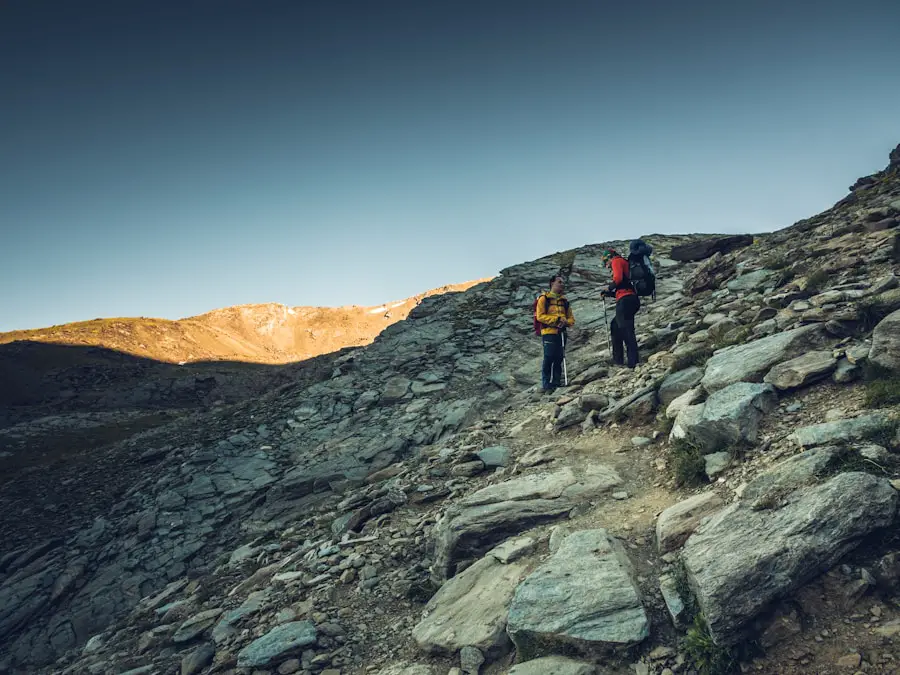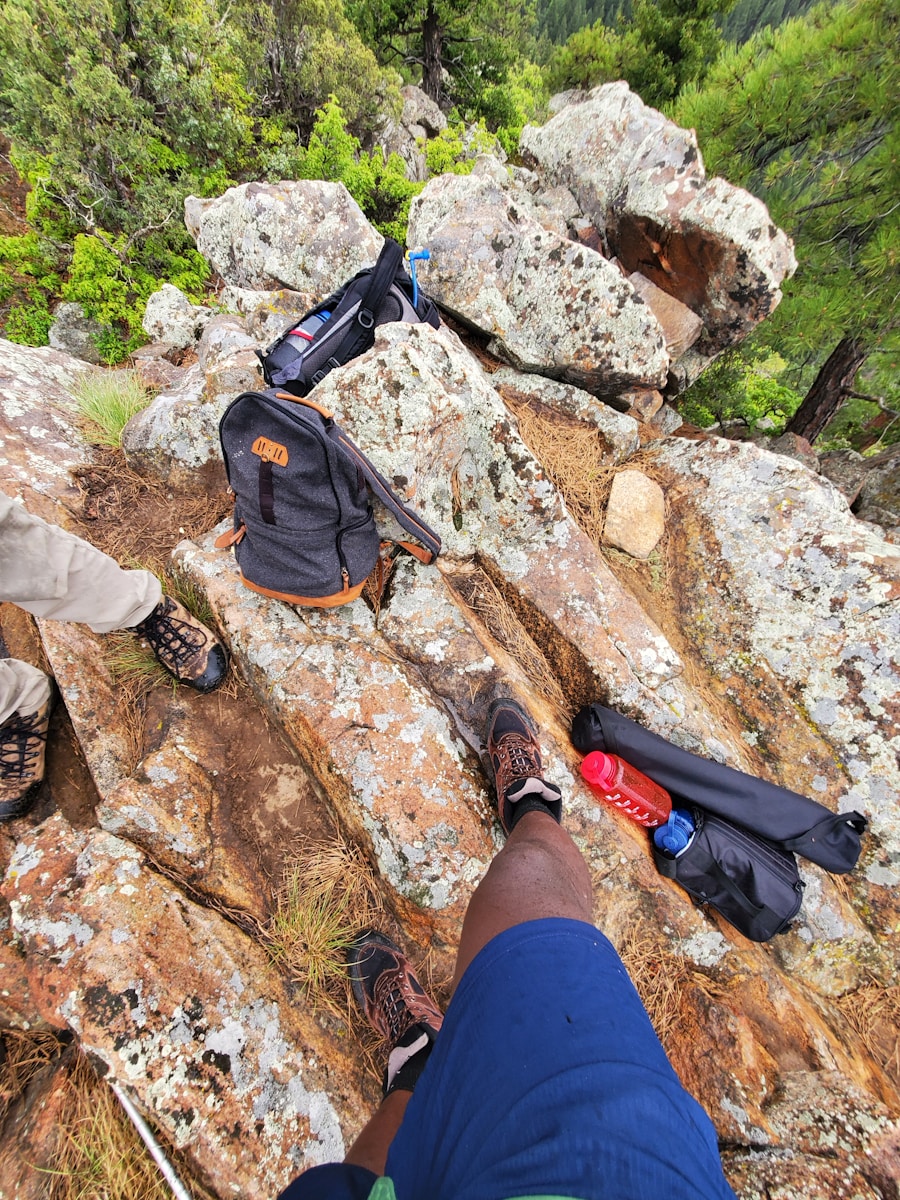Scrambling is an exhilarating form of hiking that combines elements of climbing and trekking, allowing adventurers to traverse rugged terrains that are often inaccessible by traditional hiking routes. This activity typically involves navigating steep, rocky paths where the use of hands is necessary for balance and stability. Unlike technical climbing, which requires specialized equipment and skills, scrambling is generally considered a less formalized approach to ascending challenging landscapes.
It invites hikers to engage with nature in a more intimate way, fostering a sense of adventure and exploration. The appeal of scrambling lies in its ability to offer a unique blend of physical challenge and mental stimulation. As hikers ascend rocky outcrops or navigate narrow ledges, they must remain acutely aware of their surroundings, making real-time decisions about their footing and handholds.
This dynamic interaction with the environment not only enhances the physical experience but also cultivates a deeper appreciation for the natural world. Scrambling can be found in various locations, from the craggy peaks of the Rockies to the rugged coastlines of Wales, making it a versatile activity for outdoor enthusiasts.
Key Takeaways
- Scrambling in hiking involves using hands and feet to navigate steep and rocky terrain, adding an element of adventure to the hiking experience.
- Understanding the challenges of scrambling, such as exposure to heights, loose rock, and route finding, is crucial for safe and enjoyable scrambling.
- Essential gear for scrambling includes a helmet, sturdy footwear, and a harness, while techniques like route planning and using handholds and footholds are important for success.
- Navigating steep terrain and loose rock requires careful foot placement, maintaining three points of contact, and being mindful of potential rockfall.
- Assessing risk and implementing safety measures, such as checking weather conditions and carrying a first aid kit, are essential for a safe scrambling experience.
Understanding the Challenges of Scrambling
While scrambling can be an exhilarating experience, it is not without its challenges. One of the primary difficulties lies in the unpredictability of the terrain. Unlike well-marked trails, scrambling routes can vary significantly in difficulty and safety.
Hikers may encounter loose rocks, steep drop-offs, and sudden changes in weather that can complicate their ascent. The need for constant vigilance is paramount; a momentary lapse in concentration can lead to slips or falls, which can have serious consequences. Another challenge is the physical demand that scrambling places on the body.
It requires not only strength and endurance but also agility and coordination.
Hikers must be prepared to use their upper body to pull themselves up steep sections while simultaneously maintaining balance on uneven surfaces. This combination of physical exertion and mental focus can be taxing, especially over prolonged periods.Additionally, the psychological aspect of scrambling cannot be overlooked; many individuals may struggle with fear of heights or anxiety when faced with exposure on narrow ledges.
Essential Gear and Techniques for Scrambling

When preparing for a scrambling adventure, having the right gear is crucial for both safety and comfort. A sturdy pair of hiking boots with good ankle support and a grippy sole is essential, as they provide stability on uneven surfaces. Additionally, wearing breathable clothing that allows for a full range of motion can enhance performance during strenuous sections.
A helmet is also highly recommended, particularly in areas where rockfall is a risk; it serves as a protective measure against falling debris. In terms of techniques, effective scrambling involves a combination of foot placement, body positioning, and handholds. Hikers should focus on maintaining a low center of gravity by bending their knees and keeping their body close to the rock face.
This position not only enhances balance but also allows for better control when navigating tricky sections. Utilizing three points of contact—two hands and one foot or two feet and one hand—can provide additional stability as hikers move through challenging terrain. Practicing these techniques in a controlled environment before tackling more difficult routes can build confidence and improve overall scrambling skills.
Navigating Steep Terrain and Loose Rock
| Location | Steep Terrain Grade | Rockfall Frequency |
|---|---|---|
| Yosemite National Park, USA | 60% | High |
| Swiss Alps, Switzerland | 70% | Medium |
| Himalayas, Nepal | 80% | Low |
Steep terrain presents unique challenges that require careful navigation and strategic decision-making. When approaching a steep section, it is essential to assess the rock quality and stability before committing to a route. Loose rocks can create hazardous conditions, leading to slips or falls that may not only endanger the scrambler but also those below them.
To mitigate this risk, hikers should test handholds and footholds before fully committing their weight to them. In addition to assessing rock quality, understanding how to move efficiently on steep terrain is vital. Short, deliberate movements often yield better results than long strides or leaps, which can lead to loss of balance.
When traversing loose rock, it is advisable to keep weight distributed evenly and to avoid sudden movements that could dislodge stones. Employing techniques such as “scooting” or “sitting” on larger boulders can provide stability while allowing for safe transitions between different sections of the scramble.
Assessing Risk and Safety Measures in Scrambling
Risk assessment is an integral part of any scrambling adventure. Before embarking on a scramble, hikers should conduct thorough research on the route, including its difficulty level, potential hazards, and weather conditions. Understanding one’s own skill level is equally important; attempting a route that exceeds personal capabilities can lead to dangerous situations.
It is advisable to start with easier scrambles and gradually progress to more challenging ones as skills and confidence develop. Safety measures should also be prioritized during the scramble itself. Carrying a first aid kit equipped with essentials such as bandages, antiseptic wipes, and pain relief medication can be invaluable in case of minor injuries.
Additionally, having a reliable means of communication—such as a fully charged mobile phone or a satellite messenger—can provide peace of mind in case of emergencies. It is also wise to inform someone about your planned route and expected return time; this ensures that help can be summoned if necessary.
Building Confidence and Mental Preparedness for Scrambling

Confidence plays a crucial role in successful scrambling experiences. Many individuals may find themselves intimidated by heights or challenging terrain; however, building mental resilience can significantly enhance performance. Visualization techniques can be beneficial; by mentally rehearsing each step of the scramble before attempting it physically, hikers can reduce anxiety and increase focus.
This practice allows individuals to familiarize themselves with potential challenges and develop strategies for overcoming them. Additionally, engaging in regular physical training can bolster confidence levels. Strengthening exercises that target core muscles, legs, and upper body can improve overall fitness and enhance scrambling abilities.
Practicing mindfulness techniques such as deep breathing or meditation can also help manage anxiety during challenging sections of a scramble. By cultivating both physical strength and mental fortitude, hikers can approach scrambling with greater assurance and enjoyment.
Tips for Planning and Executing a Scrambling Hike
Effective planning is key to executing a successful scrambling hike. Start by selecting an appropriate route based on your skill level and experience; resources such as guidebooks or online forums can provide valuable insights into various scrambles in your area. It’s also important to check weather forecasts leading up to your hike; adverse conditions such as rain or snow can significantly increase risks associated with scrambling.
On the day of the hike, ensure you arrive early to allow ample time for your ascent without feeling rushed.
A well-planned itinerary should include breaks for hydration and nutrition; maintaining energy levels is essential for tackling challenging sections effectively. During the scramble itself, communicate clearly with fellow hikers if you are part of a group; establishing signals or cues can enhance safety when navigating tricky areas together.Embracing the Adventure of Scrambling
Scrambling offers an unparalleled opportunity to connect with nature while challenging oneself physically and mentally. The sense of accomplishment that comes from successfully navigating difficult terrain fosters personal growth and resilience. Each scramble presents unique challenges that encourage problem-solving skills and adaptability; these experiences often translate into other areas of life beyond hiking.
As you embrace the adventure of scrambling, remember that every journey is an opportunity for learning and self-discovery. Whether you are scaling rocky cliffs or traversing narrow ledges, each step taken contributes to your growth as an outdoor enthusiast. The thrill of reaching new heights—both literally and figuratively—makes scrambling not just an activity but a transformative experience that enriches one’s appreciation for the great outdoors.
If you’re looking to enhance your hiking experience, consider investing in one of the 5 Must-Have Minimalist Travel Backpacks for Spring Adventures 2025. These backpacks are designed to be lightweight and durable, making them perfect for scrambling up rocky terrain or navigating through dense forests. With features like padded straps and multiple compartments, these backpacks will keep you organized and comfortable on your next hiking trip.
Love travel? Join Our Facebook Community For More Tips.
FAQs
What is scrambling in hiking?
Scrambling in hiking refers to a method of ascending steep or rocky terrain that involves the use of hands as well as feet. It is a step up from hiking and requires more technical skills and agility.
How is scrambling different from hiking?
Scrambling involves steeper and more rugged terrain compared to regular hiking. It often requires the use of hands for balance and support, and may involve navigating through rocky or uneven surfaces.
What equipment is needed for scrambling?
For scrambling, hikers may need specialized equipment such as a helmet, harness, and rope for safety. Sturdy hiking boots with good grip are also essential, as well as gloves for hand protection.
What are some popular scrambling routes?
Popular scrambling routes include the Aonach Eagach ridge in Scotland, Crib Goch in Snowdonia, and the Cuillin Ridge on the Isle of Skye. These routes offer challenging and rewarding scrambling experiences for hikers.
What skills are required for scrambling?
Scrambling requires a good level of fitness, as well as skills in route finding, rock climbing, and navigation. Hikers should also have a good understanding of safety techniques and be comfortable with exposure to heights.
